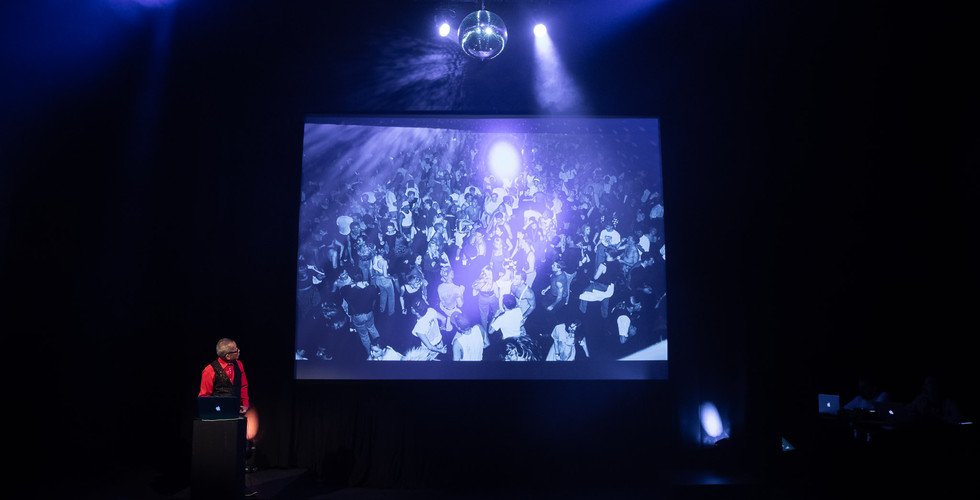Review: Party (Verb) at the Sydney Opera House
- Theatre Travels

- May 12, 2019
- 3 min read
By Laura Heuston
Upon entering the Playhouse theatre in the Sydney Opera House, I was immediately struck by the similarity of the set of Party (Verb) to a Sydney University lecture, complete with a huge screen displaying a PowerPoint, black text on a red background, and a small podium stage right. However, this was the only lecture I’ve ever attended that featured a penis on the second slide, a lecturer in a sparking vest, colourful lights, house music, and a standing ovation. It would appear that I did the wrong degree.
Party (Verb) is indeed a PowerPoint presentation but rather than statistics and notes we were treated to the photography of William Yang, our lecturer, who chronicles his experience as a gay Asian photographer living in Sydney throughout the 70s, 80s and 90s, and the vibrant party scene that once called this city home. The photos are erotic, flamboyant, candid, sophisticated, moving, intimidating, and deeply nostalgic for freedom and levity that is now mostly lost to our city. This depiction is, of course, a romanticisation of decades past, however Yang does not shy away from the gritty side of his beloved parties. Drugs and BDSM naturally feature, and the necessity for activism and fear of AIDS permeate much of the presentation, especially during the 90s.
Yang’s presentation is at its heart a personal history, and as such features characters known and loved by the photographer. Adam Booth, Yang’s lover who also had “a lawyer, hairdresser and theatre director”, makes frequent appearances, as does Peter Tully who was the Mardi Gras convenor from 1982-6. Tragically, both of these narratives conclude in the 90s, as Yang presents with grace and dignity the AIDS crisis and previously seen photos of party goers who lost their lives to the disease. Names upon names are listed by the photographer throughout the show, and names upon names appear on the screen as he details how he attended more funerals than parties in this decade, and that it was at the communities lowest point that their enemies tried to destroy them. Hope was never lost however, with his photographs shifting from wild parties to seas of mourners and supporters, standing in solidarity with those most devastated. And then back to wild parties.
The personal nature of Yang’s presentation allowed for much levity throughout. Opening with “I didn’t have sex with a man until my mid 20s” Yang was met with the response of “Liar!” from a rather talkative audience member, and a roar of laughter swept the room. His dry reply of “I would know” elicited even more gaiety, and began the piece in a joyful, intelligent mood. This was contributed to by the fact that many of the audience members also lived these experiences. A photo would appear and a collective “oh” would dance around the room, as people recognised their past. It was touching, and the warmth of the audience towards Yang, and vice versa, was palatable.
As the photos continued, one could not help but notice the absence of women. Yang is aware of this omission however, admitting that he agrees with his friend Fiona Winning when she says “he does not photograph enough women”. He goes out of his way to name female performers such as Grace Jones, Katie Latter, Edwina Blush and Carmon, a “famous Maori trans woman”.
This is unfortunately, the only time the word trans is said in the show. He also briefly touches on Cath Phillips’ Presidency of the Mardi Gras in 1989 and the fact that this was the year it became the Sydney Gay and Lesbian Mardi Gras. His story is by no means a sexist one, and he takes pains to ensure this, however it does serve as an illustration of the historical divide between these communities and the subsequent issues that have emerged.
Fundamentally though, for a young queer person living in Sydney now, Party (Verb) throws our current city into stark and grim contrast with the dazzling world of decades gone by. In a New South Wales of lock-out laws, disenfranchised festivals, and police that insist on being everywhere (including in the Mardi Gras parade, somehow) a young person emerges from Party (Verb) wondering where that scene is now, and having to bitterly accept that it was in many senses crushed. This is never to say that this scene encapsulates all of queer Sydney culture, that it is completely gone, or that it is for everyone. But there can be no doubt that the choice to attend such events is far more limited now, despite many of the more dangerous aspects having since been addressed through education and medical breakthroughs. In my opinion, our government would do well to remember Yang’s closing remark:
“Life is meant to be enjoyed.”
Photo Credit: Daniel Boud
All opinions and thoughts expressed within reviews on Theatre Travels are those of the writer and not of the company at large.










































